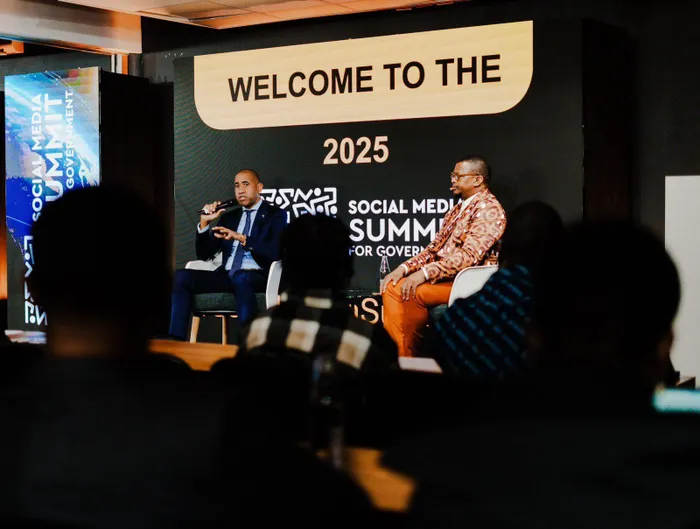Digital Platforms should be appreciated as Innovative Citizen Engagement

Professor of Practice Eldrid Jordaan speaks during a fireside chat with Decode's Lorato Tshenkeng following his keynote address at the 2025 Social Media Summit for Government. Digital platforms are revolutionising citizen engagement in South Africa, bridging the gap between government and communities while addressing the digital divide, writes Matshepo Seedat.
Image: Decode Communications
In national government, all Ministers and Deputy Ministers are required to host 10 community engagements in a financial year, each reaching at least 1,000 people. This is to ensure government leaders are in communities building with communities. A few years ago, during the Fourth Administration of government, this was a key component of their responsibilities. So critical was this obligation that I remember compiling reports on the community engagements led by the Deputy Minister in the Presidency responsible for youth at the time.
The Deputy Minister responsible for youth called BackChat: Youth Conversations for a Better South Africa. These conversations provided a space for young people to engage directly with government leaders about the issues about their development. The format was simple yet effective: 10–15 young people gathered around a table with a moderator who would frame the discussion and provoke meaningful dialogue on a specific topic.
While the in-room participation was between a few people, the true reach of these engagements was far greater. Through partnerships with media houses such as Independent Media. As well as using then-emerging social media platforms i.e. Facebook and X (formerly Twitter) — we expanded the reach significantly. Remarkably, every Friday evening when these conversations took place, BackChat would trend at number one on X. This was a time when government treated social media primarily as a one-way channel to disseminate information and not as a space for dialogue. Yet, BackChat reared that trend by using these platforms for genuine, real-time engagement.
One day, while compiling a report for Cabinet on the Deputy Minister’s community engagements, it occurred to me that BackChat itself was a legitimate community engagement platform. It met all the requirements of community engagement:
- Young people are a community ✔️
- Our analytics showed that each session reached over 3,000 people, most of them youth ✔️
- Moderators ensured that questions from the online audience were incorporated into the in-room conversation ✔️
Importantly, the online audience actively engaged through likes, shares, retweets, comments, and questions.
This clearly met the criteria for a reportable community engagement. However, at the time, it was dismissed—because we hadn’t physically seen the people. The emphasis was on tangible, in-person interactions, and digital platforms were not yet considered legitimate sites of engagement.
Fast forward to the Social Media Summit for Government, which took place on June 30 (International Social Media Day) and July 1, 2025, hosted by Decode Communications. One of the most powerful takeaways for me was a concept shared by David Vahle from YouKnow, in his talk titled:
'Digital Town Hall: How Social Listening Powers Public Service'
This concept struck a chord. The idea that town hall meetings—long considered the gold standard for citizen engagement—are now also taking place online is not only valid, but increasingly essential. These digital town halls offer several key advantages as they remove barriers to access, allow for unfiltered, unmediated interaction between citizens and government. They are also cost-effective thereby reducing the financial burden on the taxpayer. Most importantly, they meet people where they are.
That said, I am not suggesting that in-person engagement should be done away with. In Africa, and particularly in South Africa, the digital divide remains a harsh reality. Millions of citizens still do not have access to reliable internet or smart mobile devices. Data remains ridiculously expensive, and connectivity in rural and impoverished areas is inconsistent at best.
This means that while digital engagement is a powerful tool, it is not yet a universal one. As government communicators we recognise that not all South Africans are online—and that digital platforms often exclude the most vulnerable. This is why hybrid models, such as the live-streamed Presidential Izimbizo that combine in-person and online attendance, are crucial. They offer a bridge between tradition and innovation, between inclusivity and progress.
One of the most exciting evolutions in this space is the use of analytics to measure the depth and quality of engagement. Tools like platform insights, reach metrics, engagement rates, sentiment analysis, and audience demographics allow communicators to quantify the size and scope of participation and justify the impact of digital engagements in reporting frameworks, such as the reports that Ministers and Deputy Ministers are still expected to report on in the 7th administration. They can also assist in understanding what messages resonate with different groups and demographics, especially given the diversity of South Africans as well as track patterns in public sentiment and feedback.
BackChat’s analytics revealed that we were not just broadcasting messages, we were facilitating conversations. These insights should have been enough to qualify it as a community engagement. Today, with improved tools and frameworks, digital analytics can and should be integrated into the formal reporting process for community engagements.
Finally, digital platforms are no longer secondary to community engagement, they are central to it. Government must embrace digital engagement, not as a threat to tradition, but as a complement to it, especially in an era where the public sentiment is expressed online as it is on the ground.
At the same time, we must confront the digital divide with urgency and compassion, ensuring that our efforts to modernise do not come at the expense of inclusivity. The future of public engagement is hybrid, data-driven, and above all responsive.
* Matshepo Seedat is a Communication Specialist in the Presidency.
** The views expressed do not necessarily reflect the views of IOL or Independent Media.
Related Topics: